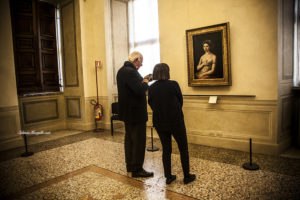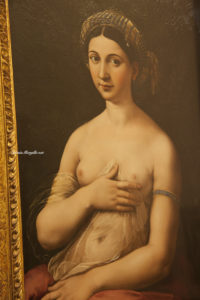Raphael and La Fornarina, the love story
Italian Version below*
After looking at this female portrait for a few seconds, a very simple question arises: Who does it represent? Who was this sweet girl?
For years, critics have asked themselves the same question and despite numerous studies, no unanimous conclusion has been reached. A large number of scholars are inclined to identify with Margherita Luti, of Sienese origin, daughter of a baker from Trastevere in the district of San Dorotea and, for this reason, known by the name of Fornarina.
The chronicles tell that Raphael had met her during the period in which she worked on the frescoes for the villa of Agostino Chigi in Via Della Lungara in Trastevere. In a moment of pause walking through the streets of the characteristic neighborhood, it seems that Raphael had stumbled upon the gaze of this young girl and had lost his head … literally.
He was so distracted and in love that Agostino Chigi invited Fornarina to the Villa to encourage him to work quickly.
The work can be dated between 1518-1519 and ranks in the artist’s catalog as one of the last to be made, before the early death in 1520 at the age of 37, from a disease resulting from “amorous excesses”.
This portrait is full of mystery and charm! The girl’s face has similarities with other works: the Veiled and the Triumph of Galatea to name a few.
A question arises: is it always the same subject that Raphael replies? La Fornarina looks like a modern Venus and an inspiring muse; extremely sensual in being wrapped in a simple veil, proud of the bracelet worn on the arm with the inscription “Raphael Urbinas”.
Recent diagnostic studies have highlighted several “repentances”, starting with the presence of a ring on the left ring finger and the background originally purely Leonardesque and in the final version devoted to the theme of love with the myrtle bush dear to Venus and the quince branch alluding to love worldly.
From 1642, the work becomes part of the family’s inventories Barberini and today it is exhibited in the marvelous Palazzo of the same name in the center of Rome.
InfoSite: Barberini Gallery
Perhaps not everyone knows that…. In the Trastevere district in Via di Santa Dorotea at number 20, a fifteenth-century building with a characteristic window framed by a round arch is visible … For many, this was precisely the house of the Fornarina!
All rights reserved*
Dopo aver guardato per pochi secondi questo ritratto femminile, ci si pone una domanda semplicissima: Chi rappresenta? Chi era questa dolce fanciulla?
Per anni la critica si è posta la stessa domanda e nonostante i numerosi studi non si è giunti ad una conclusione unanime. Un gran numero di studiosi propende per l’identificazione con Margherita Luti, di origine senese, figlia di un fornaio di Trastevere della contrada di San Dorotea e, per questo, nota con il nome di Fornarina.
Raccontano le cronache che Raffaello l’avesse incontrata nel periodo in cui lavorava agli affreschi per la villa di Agostino Chigi in Via della Lungara a Trastevere. In un momento di pausa camminando per le stradine del caratteristico rione, sembra che Raffaello si fosse imbattuto nello sguardo di questa giovane fanciulla e ne avesse perso ….letteralmente la testa.
Era così distratto ed innamorato che Agostino Chigi per spronarlo a lavorare velocemente, invitò la Fornarina all’interno della Villa.
L’opera è databile tra il 1518-1519 e si pone nel catalogo dell’artista come una delle ultime realizzate, prima della precoce morte avvenuta nel 1520 a soli 37 anni, per una malattia derivante da “eccessi amorosi”.
Questo ritratto è ricco di mistero e fascino! Il volto della ragazza ha delle similitudini con altre opere: la Velata ed il Trionfo di Galatea per citarne alcune. Ci si pone una domanda: è sempre lo stesso soggetto che Raffaello replica? La Fornarina si presenta come una moderna Venere ed una musa ispiratrice; estremamente sensuale nel suo essere avvolta in un semplice velo, fiera del bracciale indossato sul braccio con la scritta “Raphael Urbinas”.
Recenti studi diagnostici hanno messo in luce diversi “pentimenti”, a partire dalla presenza di un anello sull’anulare sinistro e dello sfondo in origine prettamente leonardesco e nella versione definitiva consacrato al tema dell’amore con il cespuglio di mirto caro a Venere ed il ramo di cotogno allusivo all’amore mondano.
Dal 1642, l’opera entra a far parte degli inventari della famiglia Barberini ed oggi è esposta nel meraviglioso omonimo Palazzo in pieno centro a Roma.
InfoSite: Galleria Barberini
Forse non tutti sanno che…. Nel rione di Trastevere in Via di Santa Dorotea al civico 20 è visibile un palazzo quattrocentesco con una caratteristica finestra incorniciata da un arco a tutto sesto… Per molti era proprio questa la casa della Fornarina!
Sostieni #laculturachevince, aiuta la condivisione.

